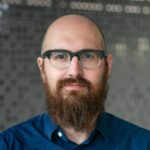
Daniel Paull, PhD
Senior Vice President, Discovery & Platform Development at NYSCF
PhD, University College London
Bio
Dr. Paull oversees the NYSCF Global Stem Cell Array® – our automated technology for creating stem cells at a large scale – and has been at NYSCF since 2011. His unique expertise falls at the intersection between biology and engineering, allowing stem cells to be used to model a variety of diseases in large patient populations. These large-scale experiments are orders of magnitude larger than any typically conducted by hand.
Dr. Paull received his PhD in Ophthalmology and Cell Biology from University College London, England, and performed his postdoctoral work in the lab of Dr. Dieter Egli at NYSCF. In the latter role, he laid the groundwork for developing the NYSCF automation systems by gaining a firm understanding of how to create stem cells and turn them into the other cell types of the body, including the development of somatic cell nuclear transfer – a method for generating patient-specific embryonic stem cells.
He was also instrumental in developing a technique called mitochondrial replacement therapy (MRT) in which mutated mitochondrial DNA (genetic material inherited maternally) is replaced with that of a healthy donor during the in vitro fertilization process. The aim of this technique is to prevent the inheritance of incurable mitochondrial diseases from mother to child, and is now in clinical trials in the United Kingdom.
Dr. Paull’s work was pivotal in developing the core technology for the NYSCF Global Stem Cell Array®, including automation of the process of converting skin and blood cells to induced pluripotent stem cells (iPSCs). Combining biology with software and hardware engineering, this platform eliminates the variability that occurs when iPSCs are made by hand, and allows for large-scale experiments.
In his current role, Dr. Paull continues to improve and scale up NYSCF’s induced pluripotent stem cell (iPSC technology), and to oversee its application to collaborative projects across the research community. He also leads NYSCF’s efforts to combine automation, imaging, and artificial intelligence to detect hidden features of disease and discover new drugs.
Mentioned In
- New Frontiers in Regenerative Medicine: Highlights of the 2023 NYSCF Conference
- Listen Up: NYSCF Talks Technology, Community, and DEIB with The Stem Cell Podcast
- NYSCF Community Showcased at the International Society for Stem Cell Research Conference
- First Children in United Kingdom Born After Receiving Mitochondrial Replacement Therapy that NYSCF Helped Pioneer
- Experts Unpack the First Stem Cell Model Study of PTSD and What it Means for Better Treatments
- The NYSCF Conference Returns in Person to Showcase Seminal Advances in Translational Stem Cell Research
- Stem Cell Study Reveals How Neurons From PTSD Patients React to Stress
- Toward Better Treatments for PTSD: Lessons Learned From The First-Ever Stem Cell Model of the Disorder
- High School Students Join NYSCF for a Week of Immersive Stem Cell Education
- NYSCF Community Shares Exciting Progress at International Society for Stem Cell Research Conference
- NYSCF Panel Featured on Dana Foundation Blog
- Spotlight on the NYSCF Global Stem Cell Array